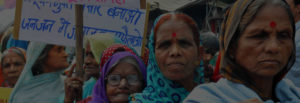Long before thousands of people created the human chain around the Ministère de l’Économie, des Finances et de l’Industrie in Paris March 9, volunteers were busy making different kinds of connections.
Conversations with small anti-nuclear associations in France months before the peaceful protest inspired networks of coalitions to spring up, says event organizer Gregory Loison.
“The most important step was the creation of a project team,” he says that was able to spark these initial conversations with 25 local groups.
The original team then took on the role of motivating those group co-ordinators to share the information about the event in which thousands were mobilised to peacefully protest against the French policy on investment into nuclear energy.
The original team did this through more conversation both in person and via conference calls, and, eventually, by sharing a most unique engagement tool — an invitation to the public to make an origami crane.
The crane is a Japanese symbol, and the story goes that if one makes 1,000 cranes, a wish will come true,” Loison says.
The wish, of course, was to stop government investment into nuclear energy. The French government is often accused of over-investing in nuclear projects.
The paper crane initiative gave on-the-ground volunteers something to use to engage the public, Loison adds.
“It helped motivate the troops,” he says.

Greenpeace volunteers engaged online and offline support by asking people to make paper cranes, a Japanese symbol for wishes-come-true.
Alongside offline conversation, connections, communication, and cranes, the French Greenpeace team created allure among the online community with a Facebook page entitled “Stop Nuke.”
The page was campaign specific before being launched about three weeks later on the main Greenpeace France page, thus extending the invitation to engage to the whole Greenpeace France online community.
A third Facebook tool was created on the main Greenpeace page to engage even wider support. This one focused on the origami cranes made at the Greenpeace France office.

Other online activists in Paris were part of an outreach a week before the event. That invitation also went to all supporters and donors in and around Paris.
Greenpeace volunteers scheduled the event itself to coincide with the second anniversary of the Japanese Fukushima explosions. In the wake of the Tohoku earthquake and tsunami March 11, 2011, a series of equipment failures and nuclear meltdowns caused the release of significant amounts of radioactive material.
It is considered the largest nuclear disaster since Chernobyl in 1986, and the plant continues to have radioactive leaks, even as recently as this month. Up to 160,000 people are still unable to return to their homes following the initial disaster.
The World Nuclear Association lists France as the world’s largest net exporter of electricity, three-quarters of which is derived from nuclear energy. In fact, one of France’s major exports is nuclear equipment such as reactors and France is currently building its first Generation III reactor.
Even as recently as April 13, the French consortium Areva announced it would be sending several tons of MOX, a compound that has up to 10 per cent radioactive plutonium to Takahama on the Korean peninsula.

Volunteers hung a chain of Japanese paper cranes on the Ministère de l’Économie, des Finances et de l’Industrie in Paris March 9 as a way of drawing attention to their wish for a halt to the French investment in nuclear power.
The day of the Greenpeace France event, at least 4,000 people (police confirm 4,000 protestors, while organizers say as many as 20,000 may have been in attendance) formed a human circle around the buildings in Paris that promote nuclear power: the Assemblée nationale and the Senat, the Ministère de l’Économie, des Finances et de l’Industrie, the seats of EDF, Areva and banks.
Greenpeace also attached 1,000 origami cranes to the Ministère de l’Économie, des Finances et de l’Industrie, in a symbolic gesture toward a wish for a world free of nuclear power.
Organizers live-tweeted the event, updated Facebook in real time, and published pictures under @greenpeacefr on Twitter. As well, local and international media picked up the event.
The co-creation of this event through the management of both online and offline volunteers, activists and other interested members of the public ensured its success, Loison says.
“Of course there was a lot of collaboration between online and offline,” he adds.
Mobilisation Takeaways:
- Establish a project team to engage in coalition building.
- Identify key organizations to manage offline information flow.
- Keep the energy high by:
- Finding and sharing unique engagement tools;
- Continued conversation;
- Finding opportunities to tie campaign into current events.
- Specifically manage online information flow.
- Engage online communities through social media repeatedly before the event, and live during the event.
More information about the project is available (in French) on the Greenpeace France site.
Stay Connected: @greenpeacefr
Related Posts:
How Greenpeace France got 13,000 to thank nuclear activists online and offline (VIDEO)
Do you have an innovation in mobilisation or people-powered campaigns? Share it with Mob Lab.




